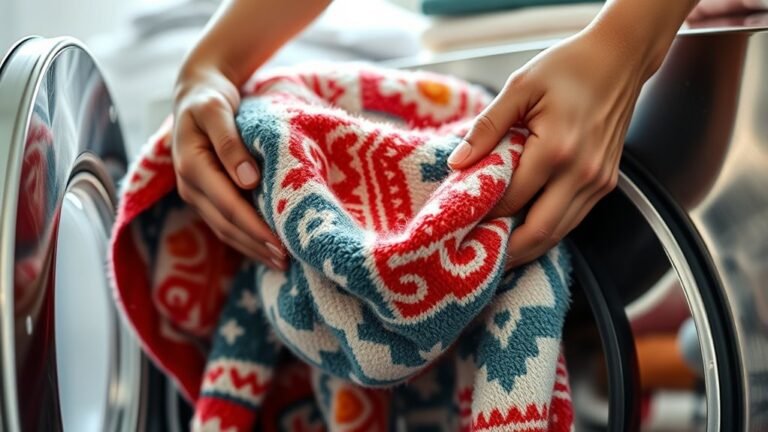Cleaning Your Home’s Light Fixtures Safely
To clean your home’s light fixtures safely, first cut power at the breaker and verify it’s off before touching anything. Gather gentle cleaners, microfiber cloths, and wear gloves to protect yourself. Dust with soft brushes or cloths, clean glass or crystal carefully, and wash metal or plastic parts with mild soap and water. Don’t forget to inspect bulbs and guarantee everything is dry before reassembling. If you want to keep your fixtures shining and secure, there’s plenty more to take into account.
Preparing Your Cleaning Supplies

Before you begin cleaning your light fixtures, make sure you’ve gathered all the necessary supplies. Having the right cleaning tools at hand will make the process smooth and efficient. You’ll want a soft cloth or microfiber duster to avoid scratches, a gentle cleaner suitable for your fixture’s material, and a sturdy ladder or step stool for easy access. Don’t forget your safety gear—wear gloves to protect your hands from grime and cleaning solutions, and safety glasses if there’s a risk of debris falling. Preparing these essentials beforehand lets you move freely and confidently, so you’re not scrambling mid-clean. With everything ready, you can tackle the task with ease, keeping your light fixtures shining bright without hassle or risk.
Ensuring Electrical Safety Before You Start
Two essential steps guarantee your safety when cleaning light fixtures: cutting power and verifying it’s off. Before you begin, locate your home’s circuit breaker and perform a power disconnection for the fixture you’re working on. This simple act frees you from the risk of electrical shock, allowing you to clean with confidence. After switching off the circuit, conduct a circuit inspection by using a voltage tester or a similar device to confirm that no electricity is flowing to the fixture. Never skip this step—assuming the power is off can lead to accidents. Taking these precautions empowers you to maintain your fixtures safely and independently, giving you the freedom to care for your home without relying on others or risking harm.
Removing Dust and Debris From Light Fixtures

Cleaning your light fixtures starts with removing dust and debris, which can dull their brightness and reduce efficiency. You want to keep your fixtures shining and maintain their freedom to illuminate your space without interference. For dust removal, gently use a microfiber cloth or a soft brush to sweep away loose particles. Avoid harsh scrubbing that could damage the fixture’s surface.
| Tool | Purpose |
|---|---|
| Microfiber cloth | Traps dust without scratching |
| Soft brush | Reaches tight corners |
| Vacuum with brush | Removes heavy debris |
| Compressed air | Blows dust from crevices |
| Ladder | Accesses high fixtures |
Regular dust removal is essential for fixture maintenance, ensuring longevity and ideal light output so you can enjoy your home freely.
Cleaning Glass and Crystal Components
After you’ve cleared away dust and debris, the next step is to focus on the glass and crystal parts of your fixtures. For effective glass care, use a gentle, streak-free cleaner and a soft microfiber cloth to avoid scratches. Spray the cleaner onto the cloth, not directly on the glass, to prevent damage to nearby components. When it comes to crystal preservation, handle each piece carefully, as crystals are delicate and prone to chipping. Soak crystal parts in warm, soapy water, rinse thoroughly, and dry with a lint-free cloth. Taking these steps guarantees your fixtures shine brightly while maintaining their integrity. By treating glass and crystal components with care, you keep your lighting fixtures looking vibrant and let your space reflect the freedom you cherish.
Handling and Cleaning Fabric Lampshades

When cleaning fabric lampshades, you’ll want to remove dust gently to avoid damage. Using a soft brush or vacuum with a brush attachment works well for this. If you encounter stains, treating them carefully with mild soap and water can help keep your shade looking fresh.
Removing Dust Gently
Although fabric lampshades are delicate, you can keep them dust-free without risking damage. Start by choosing gentle techniques that respect the fabric’s texture. Use soft dusting tools like a microfiber cloth, a feather duster, or a soft-bristle brush to avoid rough contact. Gently sweep across the lampshade’s surface, working from top to bottom to capture loose dust. Avoid pressing hard or scrubbing, as that can weaken the fabric or cause fibers to loosen. For stubborn dust in creases, a handheld vacuum with a brush attachment on low suction works well. By regularly removing dust with these gentle methods, you maintain your lampshade’s fresh look and extend its life—all without feeling tied down by complicated cleaning routines.
Stain Treatment Tips
Dealing with fabric lampshade stains can feel tricky, but a few simple steps can make the process easier and more effective. First, embrace stain prevention strategies like regular dusting and keeping food or drinks away from your lampshades to minimize risks. When stains do appear, act fast using gentle stain removal techniques: dab the spot with a mild detergent mixed with water, avoiding harsh scrubbing that could damage the fabric. For tougher stains, a mixture of vinegar and water works wonders, but always test on a small area first. Let the shade air dry completely to avoid warping. By following these straightforward tips, you’ll keep your fabric lampshades looking fresh while enjoying the freedom of a clean, inviting space.
Washing Metal and Plastic Parts
Cleaning metal and plastic parts requires a gentle touch and the right supplies to avoid damage. When you tackle metal cleaning, opt for mild soap and warm water, steering clear of harsh chemicals that can strip finishes or cause rust. Use a soft cloth or sponge to wipe down surfaces gently, preserving their shine without scratches. For plastic care, avoid abrasive scrubbers that might leave marks or cloud the surface. Instead, a soft cloth dipped in soapy water works perfectly. Rinse parts thoroughly and dry them completely to prevent water spots and corrosion. Taking these simple steps lets you maintain your light fixtures’ beauty and functionality, giving you the freedom to enjoy bright, clean lighting without worry or damage.
Cleaning Ceiling Fans and Chandeliers
When you want to keep your ceiling fans and chandeliers looking their best, it’s important to approach their cleaning with care. For effective ceiling fan maintenance, start by turning off the power to avoid accidents. Use a microfiber cloth or a gentle duster to remove dust from the blades, and if needed, a mild detergent diluted in water for deeper cleaning. Chandeliers, especially delicate chandelier styles like crystal or vintage glass, require a soft touch—wipe each piece gently with a damp cloth or use special chandelier cleaner sprays. Avoid soaking any electrical components. Taking these precautions lets you maintain your fixtures’ beauty and functionality while enjoying the freedom of a well-lit, dust-free space.
Maintaining Light Bulbs During Cleaning
When cleaning your light fixtures, make sure you handle the bulbs gently to avoid damage. Take a moment to inspect each bulb for any signs of wear or cracks. This simple check can help you prevent potential hazards and keep your lights working safely.
Handling Bulbs Carefully
Although handling light bulbs may seem straightforward, treating them with care is crucial to avoid damage or injury. When you’re cleaning, remember that different bulb types—incandescent, LED, or CFL—require gentle handling to preserve their bulb lifespan. Always grip bulbs by their base, never the glass, to prevent oils from your skin from causing hot spots or premature failure. Make certain the bulbs are cool before touching them, reducing the risk of burns or breakage. Avoid twisting or forcing bulbs out; instead, turn them slowly and steadily. By respecting these simple steps, you maintain your freedom to enjoy well-lit spaces without worrying about replacing bulbs more often than necessary. Careful handling guarantees your fixtures stay bright and your cleaning process remains safe.
Checking Bulb Condition
Regularly checking the condition of your light bulbs during cleaning helps catch issues before they cause bigger problems. You’ll want to inspect for cracks, discoloration, or flickering that signal it’s time for a replacement. Knowing your bulb types makes this easier—LEDs, CFLs, and incandescents each have unique lifespans and energy efficiency levels. Keeping bulbs in top shape not only guarantees safety but also maximizes your freedom to enjoy well-lit spaces without interruption.
| Bulb Type | Energy Efficiency |
|---|---|
| LED | High (low energy use) |
| CFL | Moderate |
| Incandescent | Low |
Check bulbs regularly, swap out worn ones, and you’ll keep your home bright and safe with minimal hassle.
Reassembling and Testing Your Light Fixtures
Before you fully reassemble your light fixtures, make certain all parts are completely dry to prevent any electrical issues. Take your time reassembling fixtures, aligning each component properly to avoid damage or misfits. Use your hands gently, and avoid forcing parts together. Once everything’s back in place, it’s time for testing functionality. Turn the power back on and switch the light on to verify it works smoothly. If the light flickers or doesn’t turn on, double-check your connections and bulb condition. Reassembling and testing your light fixtures carefully lets you enjoy a well-lit space without hassle. This simple process gives you freedom from worries, keeping your home safe and bright.
Frequently Asked Questions
How Often Should I Deep Clean My Home’S Light Fixtures?
You should aim to deep clean your light fixtures every 6 to 12 months to keep them shining and functioning well. Sticking to a light fixture maintenance routine helps prevent dust buildup and extends their lifespan. Creating a cleaning schedule that fits your lifestyle gives you freedom to enjoy a bright, fresh home without hassle. Adjust it as needed, especially if your home collects dust faster or you have pets around.
Can I Use Commercial Cleaning Sprays on All Fixture Types?
Imagine your light fixtures as delicate butterflies resting in your home’s garden. You wouldn’t douse them with harsh chemicals, right? Commercial cleaner effectiveness varies, so you’ve got to take into account fixture material compatibility. Some sprays might be too harsh for glass or delicate finishes, causing damage. To keep your freedom to shine without worry, always test a small area first or choose cleaners designed for your specific fixture type. This way, you’ll keep your lights glowing safely.
What’S the Best Method to Prevent Future Dust Buildup?
To keep dust prevention effective, you’ll want to create a routine that makes fixture maintenance easy and stress-free. Regularly wiping down your fixtures with a microfiber cloth helps stop dust from settling. You can also use anti-static sprays designed for home use, which repel dust naturally. Keeping your home’s air clean with a good filter system reduces airborne dust, so your fixtures stay cleaner longer without extra hassle.
Are There Eco-Friendly Alternatives for Cleaning Light Fixtures?
You’ll be amazed how natural cleaning can turn light fixtures from dusty disasters into sparkling gems! If you want freedom from harsh chemicals, try DIY solutions like vinegar and water or lemon juice mixed with baking soda. These eco-friendly alternatives clean effectively without harming the planet or your health. Plus, they’re easy to make at home, giving you the power to maintain your space sustainably and beautifully—without sacrificing your freedom or values.
How Do I Safely Clean Outdoor Light Fixtures?
When tackling outdoor cleaning, you’ll want to keep fixture safety in mind. First, switch off power to avoid shocks. Use a soft cloth or sponge with mild soap and water to gently wipe away dirt and grime. Avoid harsh chemicals that can damage finishes. If fixtures are removable, take them down for a deeper clean. Staying safe lets you enjoy shining, fresh outdoor lights without hassle or worry.






